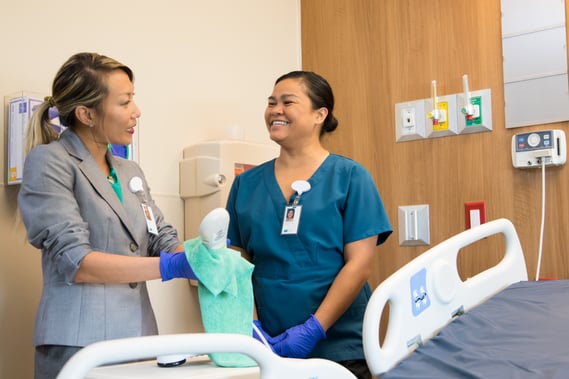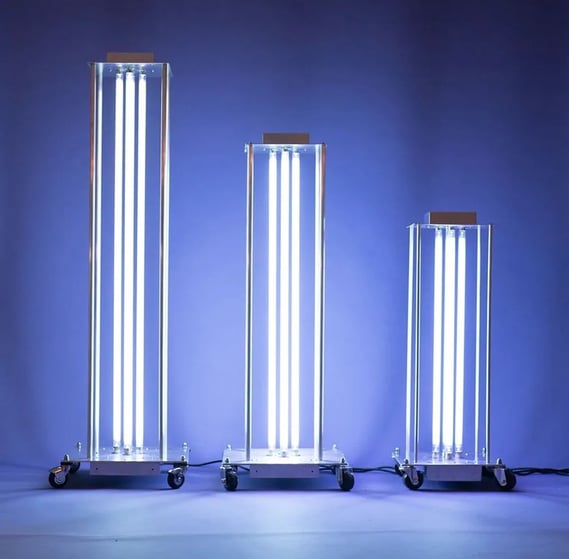UV-C light technology provides an excellent way to supplement your hospital’s disinfection protocols, adding a layer of assurance for infection prevention against pathogens, including antimicrobial-resistant ones.
What is UV-C Light Technology, and How Does It Work?
UV-C light technology uses a specific wavelength of ultraviolet light to create a germicidal effect on pathogens and render them inactive, or unable to replicate or reproduce.
The benefit of UV-C light technology is that it doesn’t depend upon antibiotics to be effective, which is especially important in the fight against HAIs and antimicrobial-resistant pathogens.
Best Practices: Making UV-C Technology Cost-Effective for Hospitals
UV-C technology machines can be expensive, with some models costing as much as $100,000 per unit. However, there are ways healthcare facilities can make it more cost-effective.
Invest in training
An all-too-common sight in hospitals are advanced machines tucked away, gathering dust in forgotten storage closets. UVConcepts understands this dilemma and created a UV technology suite focusing on portable equipment cleaning that you can train your staff to use in minutes rather than hours or days.

With high turnover in the healthcare industry, choosing a product that requires minimal training reduces onboarding time for new employees.
Pay Attention to Design
BrightBot was founded by Robert Thomann, an ER physician’s assistant who saw firsthand during the pandemic how UV-C technology can bring peace of mind as the last step in the cleaning process.

Robert was determined to create a product that was simple and cost-effective — and, therefore, actually put to use by hospitals. BrightBot machines range from $8,300 to $10,200 versus the $100,000 price tag of most competitors while providing the same powerful germicidal effect as the other machines.
Target Areas for Use
Focus on areas in your hospital where the chance for infection spread is highest.
Isolation Discharges
Include UV-C technology as the last layer of protection in any room requiring isolation, especially any C. diff discharges.
Operating Rooms (ORs)
Use UV-C technology as a part of your terminal operating room cleaning processes at least once a week in every OR.
Critical Care Areas
Intensive care units, the NICU, and anywhere patients are more vulnerable would be excellent places to use UV-C machines.
Common Misconceptions about UV-C in Healthcare
Misconception #1: UV-C Technology Replaces Cleaning
UV-C technology should be used as an added layer of protection in the fight against the spread of infection. In fact, if an area isn’t cleaned before using UV-C technology, it hinders the capabilities of the machine’s germicidal effect.
Misconception #2: UV-C Doesn’t Require Additional Labor
Setting up and using the machines correctly takes time. This can be planned efficiently — once an hourly employee has completed their cleaning process in one room, they can set up the UV-C machine to work while they clean the next room. This will eliminate any wasted time. However, the set up process does take a bit of time that must be factored into the cleaning schedule.
Misconception #3: ATP Testing Can Be Used to Validate UV-C Doses
ATP tests are not a good measure of whether or not an area has received an adequate dose of UV-C.
Adenosine triphosphate (ATP) is the energy molecule found in all living cells. ATP testing involves a luminometer to measure the amount of ATP on a surface, thereby validating how clean a surface is after traditional cleaning protocols, which aim to remove organic material.
UV-C technology doesn’t remove pathogens from the surface but instead inactivates them. The specific wavelength of UV-C light inactivates pathogens by making them unable to replicate or reproduce. As this process focuses on inactivation and not removal, ATP tests cannot measure UV-C efficacy.
UV-C machines are also intended as a supplement to traditional cleaning protocols. The ATP test might show adequate removal of pathogens on the surface from the traditional cleaning protocols, even if the UV-C machine was not correctly used.
What's Next
A lot should be taken into consideration when determining whether UV-C technology is a good fit for your hospital or healthcare facility's cleaning program. A support services partner, like HHS, can work with you to design a custom-fit process for your facility, incorporating the latest technology, such as UV-C, to meet your needs.
Editor's Note: This blog was updated on July 12, 2024 for clarity.


